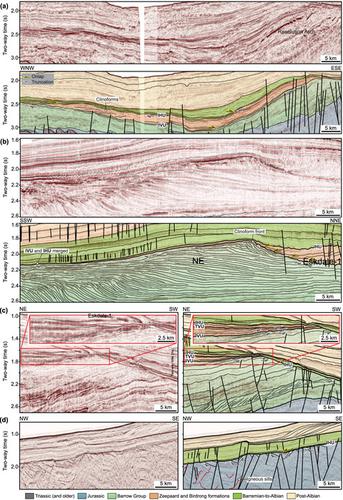当前位置:
X-MOL 学术
›
Basin Res.
›
论文详情
Our official English website, www.x-mol.net, welcomes your feedback! (Note: you will need to create a separate account there.)
Stratigraphic record of continental breakup, offshore NW Australia
Basin Research ( IF 3.2 ) Pub Date : 2022-01-11 , DOI: 10.1111/bre.12656 Matthew T. Reeve 1 , Craig Magee 1, 2 , Christopher A‐L. Jackson 1, 3 , Rebecca E. Bell 1 , Ian D. Bastow 1
Basin Research ( IF 3.2 ) Pub Date : 2022-01-11 , DOI: 10.1111/bre.12656 Matthew T. Reeve 1 , Craig Magee 1, 2 , Christopher A‐L. Jackson 1, 3 , Rebecca E. Bell 1 , Ian D. Bastow 1
Affiliation

|
Continental breakup involves a transition from rapid, fault-controlled syn-rift subsidence to relatively slow, post-breakup subsidence induced by lithospheric cooling. Yet the stratigraphic record of many rifted margins contain syn-breakup unconformities, indicating that episodes of uplift and erosion interrupt this transition. This uplift has been linked to mantle upwelling, depth-dependent extension and/or isostatic rebound. Deciphering the breakup processes recorded by these unconformities and their related rock record is challenging because uplift-associated erosion commonly removes the strata that help constrain the onset and duration of uplift. We examine three major breakup-related unconformities and the intervening rock record in the Lower Cretaceous succession of the Gascoyne and Cuvier margins, offshore NW Australia, using seismic reflection and borehole data. These data show the breakup unconformities are disconformable (non-erosive) in places and angular (erosive) in others. Our recalibration of palynomorph ages from rocks underlying and overlying the unconformities shows: (i) the lowermost unconformity developed between 134.98–133.74 Ma (Intra-Valanginian), probably during the localisation of magma intrusion within continental crust and consequent formation of continent–ocean transition zones (COTZ); (ii) the middle unconformity formed between ca. 134 and 133 Ma (Top Valanginian), possibly coincident with breakup of continental crust and generation of new magmatic (but not oceanic) crust within the COTZs; and (iii) the uppermost unconformity likely developed between ca. 132.5 and 131 Ma (i.e. Intra-Hauterivian), coincident with full continental lithospheric breakup and the onset of seafloor spreading. During unconformity development, uplift was focussed along the continental rift flanks, likely reflecting flexural bending of the crust and landward flow of lower crust and/or lithospheric mantle from beneath areas of localised extension towards the continent (i.e. depth-dependent extension). Our work supports the growing consensus that the ‘breakup unconformity’ is not always a single stratigraphic surface marking the onset of seafloor spreading; multiple unconformities may form and reflect a complex history of uplift and subsidence during continent–ocean transition.
中文翻译:

大陆分裂的地层记录,澳大利亚西北部近海
大陆分裂涉及从快速的、由断层控制的同裂谷沉降到相对缓慢的、由岩石圈冷却引起的分裂后沉降的转变。然而,许多裂谷边缘的地层记录包含同向破裂不整合,表明隆起和侵蚀的事件中断了这种转变。这种隆升与地幔上升流、依赖深度的伸展和/或均衡反弹有关。破译这些不整合面及其相关岩石记录所记录的破裂过程具有挑战性,因为与隆起相关的侵蚀通常会去除有助于限制隆起开始和持续时间的地层。我们检查了澳大利亚西北部近海的加斯科因和居维叶边缘的下白垩统序列中的三个主要与破裂相关的不整合和介入岩石记录,使用地震反射和钻孔数据。这些数据表明,解体不整合在一些地方是不整合的(非侵蚀性的),而在其他地方是有角度的(侵蚀性的)。我们对不整合面下方和上覆岩石的孢粉型年龄进行了重新校准表明:(i)最下部的不整合面发育于 134.98-133.74 Ma(瓦朗京期)之间,可能是在岩浆侵入大陆地壳内定位并随后形成大陆 - 海洋过渡期间区域(COTZ);(ii) 约形成的中间不整合面。134 和 133 Ma (Top Valanginian),可能与大陆地壳的破裂和 COTZ 内新的岩浆(但不是海洋)地壳的产生同时发生;(iii) 最上层的不整合面可能在 ca. 132.5 和 131 Ma(即内Hauterivian),与大陆岩石圈完全破裂和海底扩张的开始相吻合。在不整合发育过程中,隆起集中在大陆裂谷侧翼,可能反映了地壳的弯曲弯曲和下地壳和/或岩石圈地幔从局部延伸区域下方向大陆的陆流(即依赖深度的延伸)。我们的工作支持越来越多的共识,即“破裂不整合”并不总是标志着海底扩张开始的单一地层表面;多个不整合面可能形成并反映了大陆-海洋过渡期间复杂的隆起和沉降历史。可能反映了地壳的弯曲弯曲和下地壳和/或岩石圈地幔从局部延伸区域下方朝向大陆的向陆流动(即依赖于深度的延伸)。我们的工作支持越来越多的共识,即“破裂不整合”并不总是标志着海底扩张开始的单一地层表面;多个不整合面可能形成并反映了大陆-海洋过渡期间复杂的隆起和沉降历史。可能反映了地壳的弯曲弯曲和下地壳和/或岩石圈地幔从局部延伸区域下方朝向大陆的向陆流动(即依赖于深度的延伸)。我们的工作支持越来越多的共识,即“破裂不整合”并不总是标志着海底扩张开始的单一地层表面;多个不整合面可能形成并反映了大陆-海洋过渡期间复杂的隆起和沉降历史。
更新日期:2022-01-11
中文翻译:

大陆分裂的地层记录,澳大利亚西北部近海
大陆分裂涉及从快速的、由断层控制的同裂谷沉降到相对缓慢的、由岩石圈冷却引起的分裂后沉降的转变。然而,许多裂谷边缘的地层记录包含同向破裂不整合,表明隆起和侵蚀的事件中断了这种转变。这种隆升与地幔上升流、依赖深度的伸展和/或均衡反弹有关。破译这些不整合面及其相关岩石记录所记录的破裂过程具有挑战性,因为与隆起相关的侵蚀通常会去除有助于限制隆起开始和持续时间的地层。我们检查了澳大利亚西北部近海的加斯科因和居维叶边缘的下白垩统序列中的三个主要与破裂相关的不整合和介入岩石记录,使用地震反射和钻孔数据。这些数据表明,解体不整合在一些地方是不整合的(非侵蚀性的),而在其他地方是有角度的(侵蚀性的)。我们对不整合面下方和上覆岩石的孢粉型年龄进行了重新校准表明:(i)最下部的不整合面发育于 134.98-133.74 Ma(瓦朗京期)之间,可能是在岩浆侵入大陆地壳内定位并随后形成大陆 - 海洋过渡期间区域(COTZ);(ii) 约形成的中间不整合面。134 和 133 Ma (Top Valanginian),可能与大陆地壳的破裂和 COTZ 内新的岩浆(但不是海洋)地壳的产生同时发生;(iii) 最上层的不整合面可能在 ca. 132.5 和 131 Ma(即内Hauterivian),与大陆岩石圈完全破裂和海底扩张的开始相吻合。在不整合发育过程中,隆起集中在大陆裂谷侧翼,可能反映了地壳的弯曲弯曲和下地壳和/或岩石圈地幔从局部延伸区域下方向大陆的陆流(即依赖深度的延伸)。我们的工作支持越来越多的共识,即“破裂不整合”并不总是标志着海底扩张开始的单一地层表面;多个不整合面可能形成并反映了大陆-海洋过渡期间复杂的隆起和沉降历史。可能反映了地壳的弯曲弯曲和下地壳和/或岩石圈地幔从局部延伸区域下方朝向大陆的向陆流动(即依赖于深度的延伸)。我们的工作支持越来越多的共识,即“破裂不整合”并不总是标志着海底扩张开始的单一地层表面;多个不整合面可能形成并反映了大陆-海洋过渡期间复杂的隆起和沉降历史。可能反映了地壳的弯曲弯曲和下地壳和/或岩石圈地幔从局部延伸区域下方朝向大陆的向陆流动(即依赖于深度的延伸)。我们的工作支持越来越多的共识,即“破裂不整合”并不总是标志着海底扩张开始的单一地层表面;多个不整合面可能形成并反映了大陆-海洋过渡期间复杂的隆起和沉降历史。



























 京公网安备 11010802027423号
京公网安备 11010802027423号